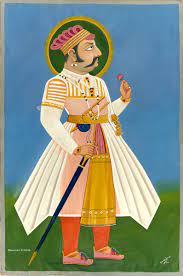Quick search
CTRL+K
Quick search
CTRL+K

King
Reign : ( 1433–1468 CE )
Born : , Rajsamand
Children : Rana Raimal, Udai Singh I, Rama Baisa
Height : : 8 feet (approx)
Weight : :
Rana Kumbha, born into a Hindu Rajput family of the Sisodia dynasty in Madariya, was the son of Rana Mokal Singh of Mewar and Sobhagya Devi. Taking the reins as the 48th Rana of Mewar in 1433 CE, he succeeded his father, embarking on a transformative journey that elevated Mewar into a prominent power.
Through astute diplomacy and strategic prowess, Kumbha expanded his realm by conquering territories like Bundi, Kotah, and Dungerpur.
He fortified his kingdom with five robust forts: Achalgarh, Kumbhalgarh, Kolana, Vairat, and Maddan.
The era witnessed remarkable advancements in art, as exemplified by intricately crafted temples. Despite formidable adversaries such as Mahmud Khalji of Malwa, Qutbuddin Ahmad Shah II of Gujarat Sultanate, Shams Khan of Nagaur, and Rao Jodha of Marwar, Rana Kumbha’s resolute defense and territorial expansion showcased his indomitable spirit and leadership.
Kumbha erected a Victory Tower at Chittor as a mark of victory of his conquests. He consolidated the fortification of Chittor and constructed a road running through its seven doors.
He constructed the city of Basantpur. He built several inns, palaces, ponds, schools, and temples.
Renowned as one of Mewar Kingdom’s greatest warriors, Maharana Kumbha’s legacy is defined by valor and strategic acumen. His adept planning secured victories over neighboring realms, notably triumphing against the Malwa and Gujarat Sultans. With an unwavering leadership, he shielded his land from Bahmani Sultanate incursions. Maharana Kumbha’s innovation shone through inventive military tactics, as he became the first Indian monarch to wield cannons in warfare. His pioneering creation, the double-walled cannon known as “Garbh Gunjam” or “thunder from the womb,” showcased his military prowess and enduring influence.
His contributions to military tactics, art, and literature have had a lasting impact on Indian culture. His legacy continues to inspire people for years.
Maharana Kumbha was the 48th ruler of the Mewar Kingdom in India. He ascended the throne in 1433 CE and is celebrated for his valor, strategic brilliance, and contributions to art, architecture, and military innovation.
Maharana Kumbha played a vital role in defending Mewar against external threats. He skillfully repelled invasions by the Bahmani Sultanate and united his forces to safeguard the kingdom’s independence.
Maharana Kumbha’s memory endures through various aspects of history and culture. He is remembered as a valiant warrior, an ingenious military strategist, a builder of architectural marvels, and a ruler who elevated Mewar’s prominence during his reign, leaving an indelible mark on Indian history.
© All rights reserved. Designed and SEO by Digital Darpan – Best SEO Company in Udaipur.